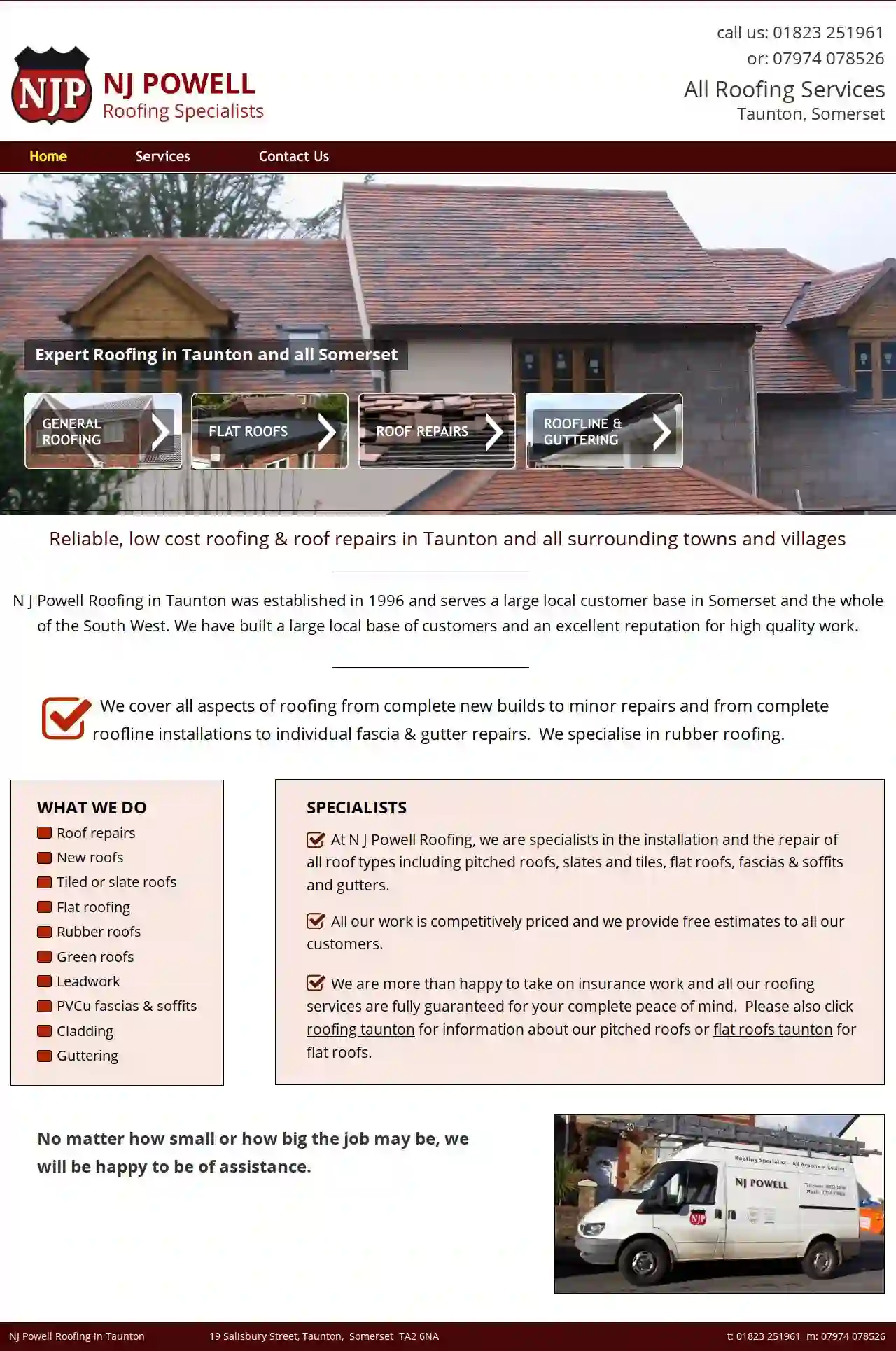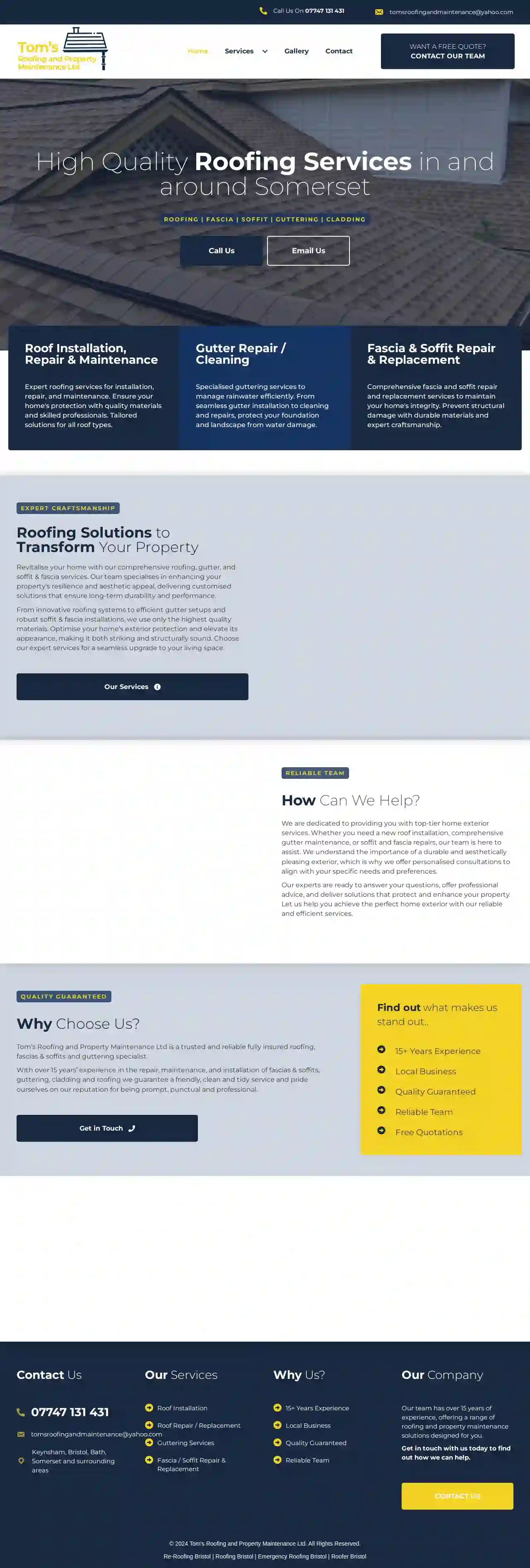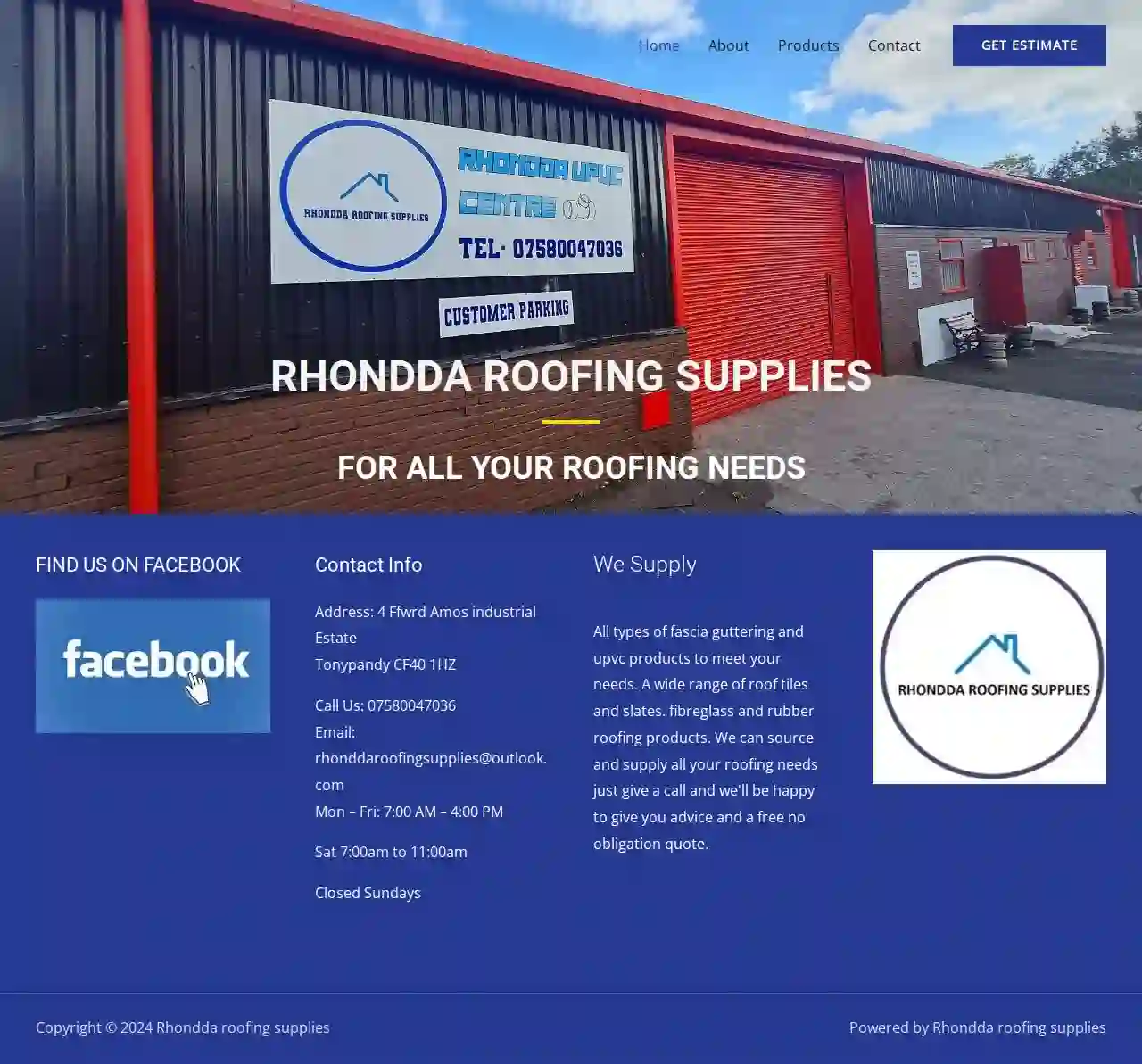Flat Roof Installers Caerdydd
Top Flat Roof Installation in Caerdydd
Get up to 3 Flat Roofing Contractor quotes for your project today! Compare profiles, reviews, accreditations, portfolio, etc... and choose the best offer.

Roofers Cardiff
55 reviewsCardiff, Unit 39448, CF11 1NB, GBRoofers Cardiff is a specialist roofing company that provides services to both residential and commercial properties in Cardiff and the surrounding areas. Our company offers a range of services, including repair, and building of flat roofs, pitched roof repair, gutter repair and lead-work, fascias, soffits, and new build roofing.Our team of expert roofers have extensive experience across the Cardiff region, meaning our skills as a company also include battening, re-felting, tiling and slating. Additionally, our company can also provide PVC fascias and Velux window installation. Call us to get a free roofing quote for your property.Every member of our team works with high professionalism and enthusiasm to offer a reliable and trustworthy service that ensures customer satisfaction. We are your local roofing contractor that provides all types of roofing services and gutter services.
- Services
- Why Us?
- Gallery
Get Quote
Ace Roofing Kildare | Ace Roofing Ireland
4.944 reviewsKilbelin, Newbridge, 1662 Páirc Mhuire, W12 CF98, GBAce Roofing & Guttering is a family-run business based in Dublin, with over 30 years of experience providing professional roofing services to clients. We are fully licensed and certified, offering a wide range of services from general roof repairs to exterior decorating. Our team of expert roofers is dedicated to providing high-quality workmanship and competitive rates, ensuring complete customer satisfaction. We are committed to delivering a truly helpful, friendly, and reliable service, backed by a 25-year guarantee on all our work.
- Services
- Why Us?
- Testimonials
- Gallery
Get Quote
B L Roofing & Building Ebbw Vale Ltd
514 reviewsGBBL Roofing & Building is a premier roofing and building company serving Ebbw Vale and across South Wales. With over 20 years of experience, we pride ourselves on providing top-quality workmanship and reliable service. We understand that your home is your most valuable asset, and we are committed to delivering exceptional results for all your roofing and building needs. Our team of skilled professionals offers a comprehensive range of services, including general roofing, guttering, emergency roofing, fascia and soffits, felt roofs, flat roof repairs, leadwork, moss removal, industrial roofing, roof windows, storm damage repairs, and more. We also offer finance options and 24/7 emergency repairs to ensure your peace of mind. Why Choose Us? * Reliable and experienced team * 10+ year warranty on all work * Professional and high-quality finish * Free no-obligation quotes We are committed to providing our clients with exceptional service and exceeding their expectations. Contact us today for a free quote and let us take care of all your roofing and building requirements.
- Services
- Why Us?
- Our Team
- Testimonials
- Gallery
Get Quote
Orchards Roofing ltd
3.326 reviews27 East Reach, Taunton, TA1 3ES, GBOrchards Roofing Ltd is your local Taunton roofing company, providing trusted and professional roofing services for both residential and commercial customers across Taunton and the South West. With over 20 years of experience, we offer a wide range of services including new roofs, flat roofs, roof repairs, chimney repairs, fascias, soffits, and guttering. We pride ourselves on our high-quality workmanship, excellent customer service, and competitive pricing. We offer free quotations and advice, so please don't hesitate to contact us today to discuss your roofing needs.
- Services
- Why Us?
- Gallery
Get Quote
County Flat Roofing
4.813 reviewsBristol, GBSpecialists in Flat Roofing Systems For Over 30 Years! Domestic & Commercial Single Ply Flat Roofing Specialists. Over the summer of 2023, founder and roofer of over 35 years Kevin Hodge, has handed over the reigns of County Flat Roofing (UK) Ltd to co-director Paul Stone. From a young age, Paul has been involved in fitting Single Ply membranes to both residential and commercial Customers. Over the years they have solved all sorts of flat roofing problems, big and small and have grown a reputation of providing a quality installations and service. We pride ourselves on providing a customer service to be proud of and instill into our personnel the importance of treating the Customer with respect at all times.
- Services
- Why Us?
- Accreditations
- Our Team
- Gallery
Get Quote
NJ Powell Roofing
44 reviews19 Salisbury Street, Taunton, TA2 6NA, GBN J Powell Roofing in Taunton was established in 1996 and serves a large local customer base in Somerset and the whole of the South West. We have built a large local base of customers and an excellent reputation for high quality work. Reliable, low cost roofing & roof repairs in Taunton and all surrounding towns and villages. We cover all aspects of roofing from complete new builds to minor repairs and from complete roofline installations to individual fascia & gutter repairs. We specialise in rubber roofing. No matter how small or how big the job may be, we will be happy to be of assistance.
- Services
- Why Us?
- Gallery
Get Quote
Roofer in Bristol - Toms Property Maintenance
512 reviewsGB- Services
- Why Us?
- Accreditations
- Our Team
- Testimonials
- Gallery
Get Quote
Rhondda Roofing Supplies Ltd
57 reviews4 Ffwrd Amos industrial Estate, Tonypandy, CF40 1HZ, GBRHONDDA ROOFING SUPPLIES FOR ALL YOUR ROOFING NEEDS Rhondda roofing supplies and Rhondda UPVC centre is an independent roofing merchant based in Tonypandy south Wales. Our aim is to provide customers with the highest quality materials sourced from our network of manufacturers to ensure our customers projects are completed to the highest possible standards. We provide an extensive range of goods to suit our customers’ needs. Contact us today we know we can help.
- Services
- Why Us?
- Gallery
Get Quote
Duraseal Roofing
51 reviewsRhondda, GBDuraseal provide a large range of roofing services including roof design, construction, and repair services to domestic and commercial customers throughout South Wales. From new builds and house extensions to offices and factories, we can work on properties of all shapes and sizes. Our team work with a variety of materials and we’re known for our high quality work and professionalism. For more information on our services, give us a call today.
- Services
- Why Us?
- Testimonials
- Gallery
Get Quote
Cardiff Roofing
52 reviewsGBCardiff Roofing is a specialist roofing company based in Cardiff, Glamorgan, Wales. We offer a comprehensive range of roofing services to both commercial and industrial clients, including roof repairs, maintenance, refurbishment, and re-roofing. We pride ourselves on our high standards of workmanship and our commitment to customer satisfaction. We have our own high lift access equipment, which allows us to work without scaffolding in the majority of cases. This means that we can offer our clients a more efficient and cost-effective service. We work closely with architects, clients, planners, and conservationists to ensure that all work carried out meets the highest standards. We incorporate the best of both old and new to ensure that a roof will last for generations to come whilst looking as it would have done originally. We provide a professional and comprehensive range of roofing services to property developers, landlords, maintenance companies, the hospitality sector, retail units, and industrial enterprises. From your first phone call, you find us an enthusiastic, knowledgeable, and professional company. We work on all commercial and industrial property types: city centre offices, new office blocks, residential apartments, company office buildings, industrial units, hospitals, schools, etc. We are experts in the construction, maintenance, and repair of all industrial and commercial roof types and provide quotes for: Metal/Steel Asbestos Skylights repair/replacement Cut edge corrosion Roof hatches Fall/edge protection Built up felt Single ply systems Flashings Cladding Gutters Re-roofing and roof raising Emergency roof repairs Customer satisfaction is crucial to Cardiff Roofing and is critical to ensuring that we continue to provide you with the best possible service in Cardiff. We provide a range of roofing services across: Annual Maintenance Programs Exploratory Roof Surveys Repairs, both large and small Reactive Emergency Repairs Cardiff Roofing has built a reputation throughout Glamorgan, Wales, and beyond for our dedication to customer care, placing your satisfaction at the core of our business.
- Services
- Why Us?
- Accreditations
- Our Team
- Testimonials
- Gallery
Get Quote
Over 12,314+ Roofing Companies in our network
Our roofing contractors operate in Caerdydd & surroundings!
Roofyng.co.uk has curated and vetted Top Roofers in and around Caerdydd. Find a top & trustworthy business today.
Flat Roof Installation FAQs
- Energy Efficiency: Cool roofs (reflective coatings, light-colored membranes) and green roofs (vegetation) are popular for reducing energy consumption and enhancing sustainability.
- Advanced Membranes: Development of more durable and long-lasting single-ply membranes with improved performance characteristics.
- Drone Inspections: Using drones for inspections, enhancing safety and efficiency in assessing large roof areas.
- Solar Integration: Integrating photovoltaic systems for renewable energy generation.
- Visual Inspection: Thoroughly examine the roof surface for any signs of damage, ponding water, or areas where the membrane is compromised.
- Water Testing: Carefully spray sections of the roof with water to observe if it penetrates the membrane. This helps pinpoint the leak's location.
- Infrared Scanning: A professional roof inspector can use infrared cameras to detect temperature differences on the roof surface, indicating areas where moisture is present.
What are the latest trends in flat roofing?
What is a roof drain, and why is it important for flat roofs?
What is the best way to find a flat roof leak?
What is the difference between a hot mop and a cold-applied flat roof?
Hot Mop: A traditional method for built-up roofing (BUR) systems, where hot asphalt is applied to the roof deck, followed by layers of felt or fiberglass. The hot asphalt acts as an adhesive and sealant, creating a waterproof membrane.
Cold-Applied: Refers to flat roofing systems that do not require heating the adhesive or sealant during installation. This category includes modified bitumen systems (applied with torches or cold adhesives), single-ply membranes (mechanically attached or adhered), and spray polyurethane foam (SPF) roofing.
Cold-applied systems are often preferred for their ease of installation, faster curing times, and reduced safety risks associated with handling hot asphalt.
What are the latest trends in flat roofing?
- Energy Efficiency: Cool roofs (reflective coatings, light-colored membranes) and green roofs (vegetation) are popular for reducing energy consumption and enhancing sustainability.
- Advanced Membranes: Development of more durable and long-lasting single-ply membranes with improved performance characteristics.
- Drone Inspections: Using drones for inspections, enhancing safety and efficiency in assessing large roof areas.
- Solar Integration: Integrating photovoltaic systems for renewable energy generation.
What is a roof drain, and why is it important for flat roofs?
What is the best way to find a flat roof leak?
- Visual Inspection: Thoroughly examine the roof surface for any signs of damage, ponding water, or areas where the membrane is compromised.
- Water Testing: Carefully spray sections of the roof with water to observe if it penetrates the membrane. This helps pinpoint the leak's location.
- Infrared Scanning: A professional roof inspector can use infrared cameras to detect temperature differences on the roof surface, indicating areas where moisture is present.
What is the difference between a hot mop and a cold-applied flat roof?
Hot Mop: A traditional method for built-up roofing (BUR) systems, where hot asphalt is applied to the roof deck, followed by layers of felt or fiberglass. The hot asphalt acts as an adhesive and sealant, creating a waterproof membrane.
Cold-Applied: Refers to flat roofing systems that do not require heating the adhesive or sealant during installation. This category includes modified bitumen systems (applied with torches or cold adhesives), single-ply membranes (mechanically attached or adhered), and spray polyurethane foam (SPF) roofing.
Cold-applied systems are often preferred for their ease of installation, faster curing times, and reduced safety risks associated with handling hot asphalt.